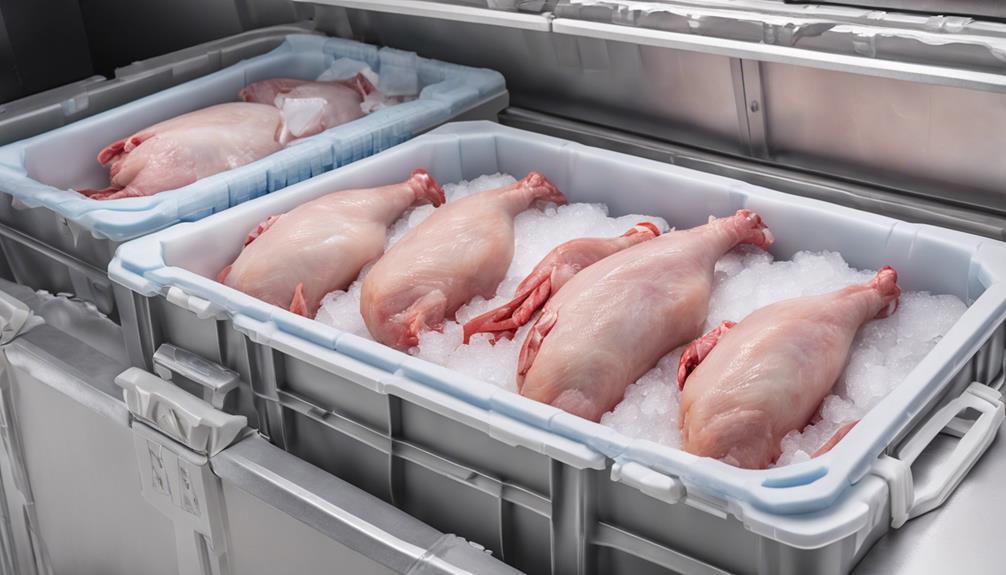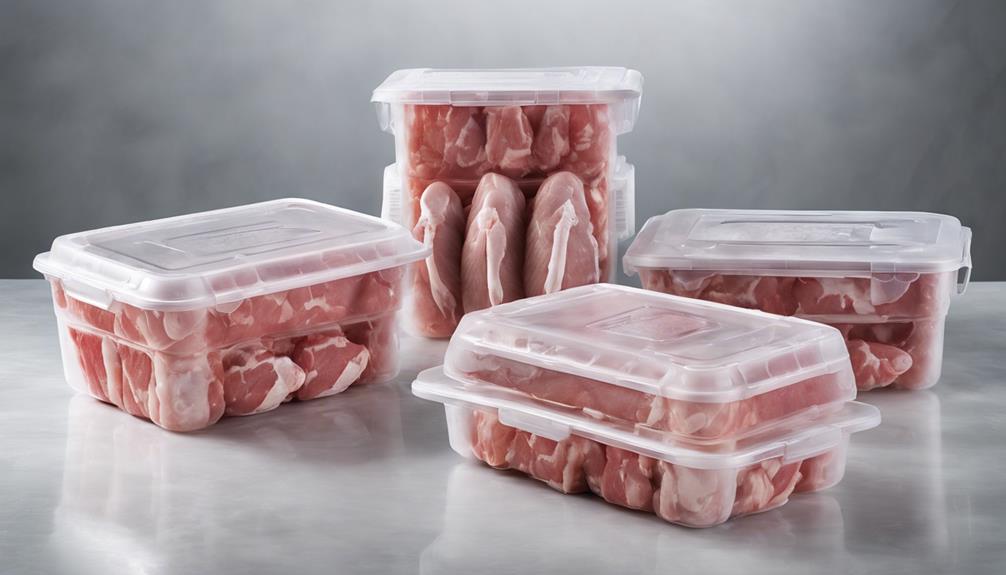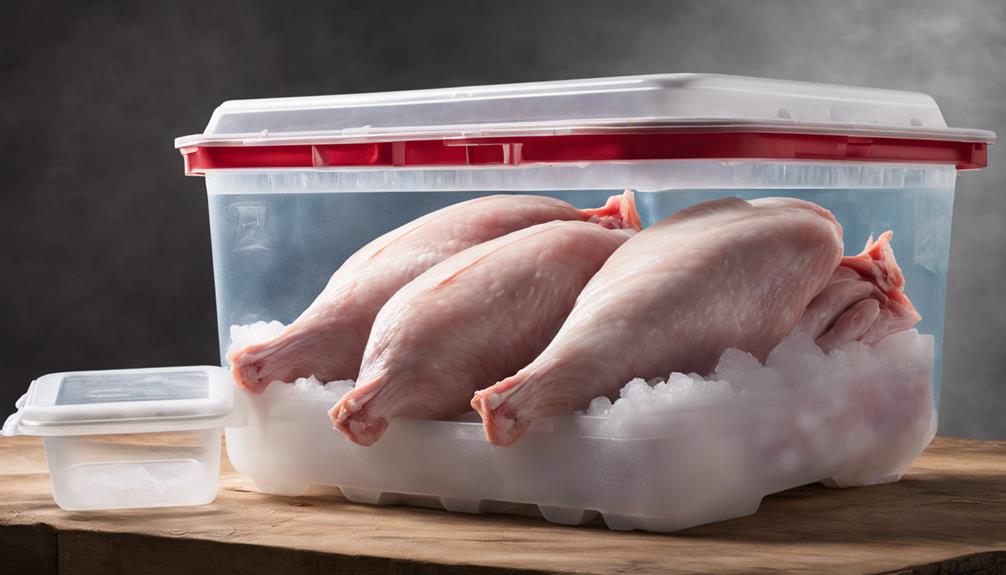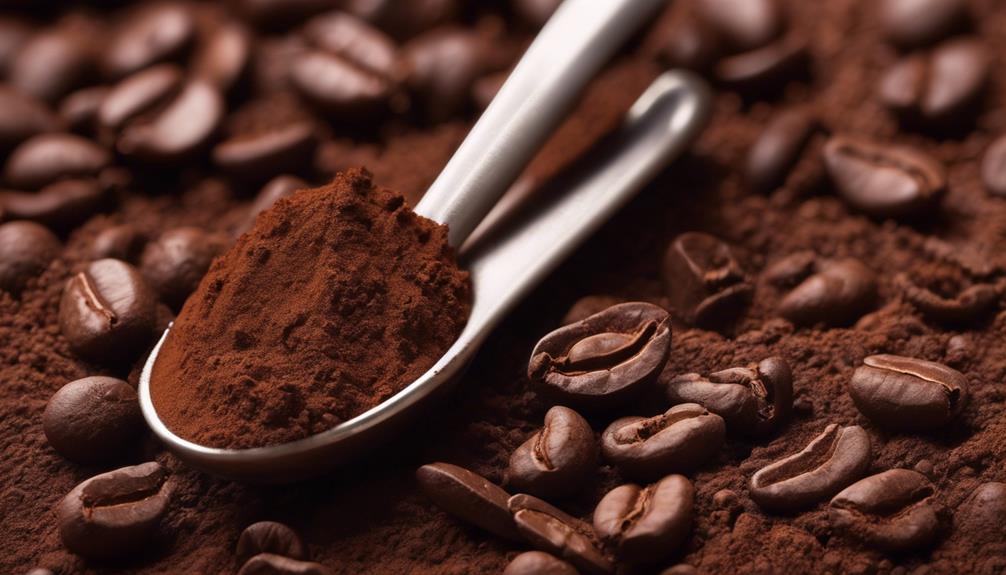When delivering off-site, it is crucial to properly store raw poultry to ensure food safety standards are met. Raw poultry must be stored at 4°C or below in leak-proof containers labeled with reheating instructions and inspection stamps. To avoid cross-contamination, raw poultry should be kept separate from ready-to-eat food and other raw meats. Maintaining a clear storage hierarchy and using suitable containers for insulation during transport is essential. Adhering to these guidelines will help maintain freshness and minimize the risk of bacterial contamination. Familiarity with these storage practices can enhance the security of the food delivery process.
Key Takeaways
- Store raw poultry separately from ready-to-eat food.
- Use leak-proof, food-grade containers for transportation.
- Maintain a lower temperature (4°C or below) for freshness.
- Implement clear labeling with reheating instructions.
- Ensure containers have insulation to control temperature.
Proper Storage Hierarchy
When storing raw poultry off-site, prioritize placing it above raw beef to prevent cross-contamination. Maintaining a significant storage hierarchy is vital for food safety during off-site delivery.
Raw poultry must be stored separately from ready-to-eat food to minimize the risk of contamination. Keeping raw poultry at a lower temperature compared to other food items to adhere to food safety standards.
Using appropriate containers that are leak-proof and food-grade is necessary when transporting raw poultry to guarantee its integrity. Additionally, all food items, including raw poultry, should be labeled with reheating instructions and inspection stamps for traceability and safety purposes.
Temperature Guidelines for Poultry

To guarantee proper food safety practices during off-site delivery of raw poultry, maintaining the correct temperature is essential. Keeping raw poultry at the right temperature range not only secures its quality but also prevents the risk of bacterial growth, which can lead to foodborne illnesses.
Here are some key guidelines to follow:
- Store raw poultry at 4°C or below to maintain freshness and reduce the chances of bacterial contamination.
- Separate raw poultry from other raw foods and ready-to-eat foods during transportation to prevent cross-contamination.
- Use appropriate containers that provide insulation and prevent leakage to maintain the proper temperature control of the raw poultry.
Preventing Cross-Contamination
Proper handling of raw poultry during off-site delivery is essential to prevent cross-contamination and guarantee food safety. When transporting raw poultry, it's important to store it separately from ready-to-eat foods to avoid any risk of contamination.
Raw poultry should always be kept at a lower temperature than ready-to-eat items to maintain food safety standards and prevent the growth of harmful bacteria. To further prevent cross-contamination, raw poultry should be stored above raw beef in transport containers. These containers must meet food safety standards, ensuring they're leak-proof to contain any potential spills or leaks from the raw poultry.
Additionally, labeling all food items, including raw poultry, with reheating instructions and inspection stamps is crucial for off-site delivery to provide clear guidance on handling and preparing the food safely. By following these practices, we can maintain the integrity of the raw poultry and guarantee the safety of the food being delivered off-site.
Suitable Transport Containers

For best food safety during off-site delivery of raw poultry, suitable transport containers must be insulated and leak-proof. When selecting the appropriate transport containers, take into account the following:
- Vital: Make sure the containers have sufficient insulation to maintain the required temperatures for raw poultry, preventing spoilage and bacterial growth.
- Guarantee: Opt for leak-proof containers to prevent any juices or liquids from raw poultry from dripping out and causing contamination.
- Size and Sturdiness: Choose containers that are spacious enough to hold the raw poultry without overcrowding, and ensure they're durable to withstand transportation conditions.
Proper transport containers play an essential role in maintaining the quality and safety of raw poultry during off-site deliveries. By investing in insulated, leak-proof containers that are appropriately sized and durable, you can make sure that the raw poultry remains fresh, uncontaminated, and safe for consumption.
Labeling and Traceability Requirements
Implementing clear labeling and robust traceability measures is paramount for ensuring the safety and quality of raw poultry during off-site deliveries. Properly labeling containers with raw poultry helps prevent cross-contamination, ensuring it's stored above raw beef and separate from ready-to-eat food to maintain food safety standards.
Additionally, storing raw poultry at a lower temperature than ready-to-eat food is vital to prevent bacterial growth and contamination. Using appropriate, leak-proof, and food-grade containers for transporting raw poultry is essential to guarantee freshness and safety during delivery.
Each food item should be labeled with reheating instructions and have an inspection stamp for traceability and quality control. By following these labeling and traceability requirements diligently, we can assure that raw poultry reaches its destination safely and maintains the highest standards of food safety for those consuming it.
Frequently Asked Questions
When Delivering Food for Off-Site Raw Poultry Must Be Stored?
When providing food off-site, I make sure that raw poultry is stored properly. It should be kept above raw beef, separated from ready-to-eat food, and stored at a lower temperature. Containers must be leak-proof and labeled for safety.
How Should You Store Recently Delivered Food?
When delivering food, I guarantee proper storage to preserve freshness and prevent contamination. I adhere to guidelines to store raw poultry separately from other meats and away from ready-to-eat foods, keeping everything labeled for safety.
What Type of Containers Should Be Used to Transport Food Offsite?
When delivering food off-site, I use insulated, leak-proof food-grade containers that can maintain the necessary temperatures. It's essential to mark containers with relevant details for safe handling. Raw poultry is always stored separately to prevent cross-contamination.
When Transporting Raw Shrimp and Potato Salad Must Be Stored When Being Transported for Off-Site Service?
When delivering off-site, raw shrimp and potato salad must be stored separately in leak-proof containers to maintain food safety. Proper insulation and temperature control are vital. Label containers with use-by dates and handling instructions.
What Are the Proper Guidelines for Storing Raw Poultry and Raw Oysters in Food Delivery?
When it comes to food delivery, adhering to the essential requirements for raw oyster establishment is crucial. Proper guidelines for storing raw poultry and raw oysters include maintaining the right temperature, separating them from other foods, and ensuring they are securely packaged to prevent cross-contamination.
Conclusion
To sum up, properly storing raw poultry when delivering off-site is essential for maintaining food safety standards. By following temperature guidelines, preventing cross-contamination, using suitable transport containers, and ensuring proper labeling and traceability, you can help protect the health of your customers.
Remember, taking these steps not only guarantees compliance with regulations but also demonstrates your commitment to delivering high-quality, safe food products.
So, let's keep those poultry products fresh and safe for everyone to enjoy!










